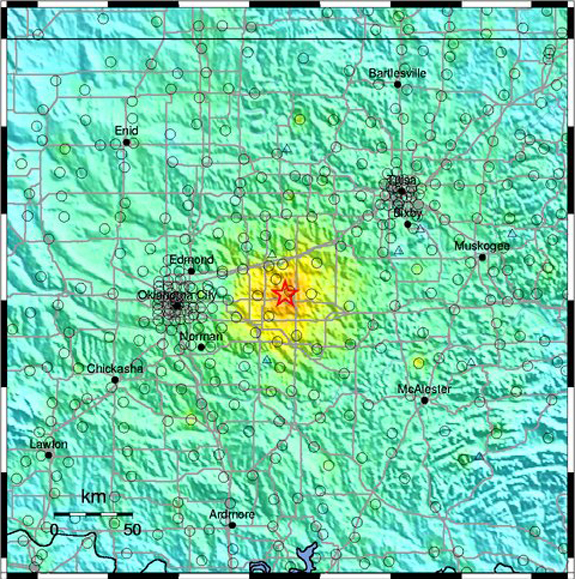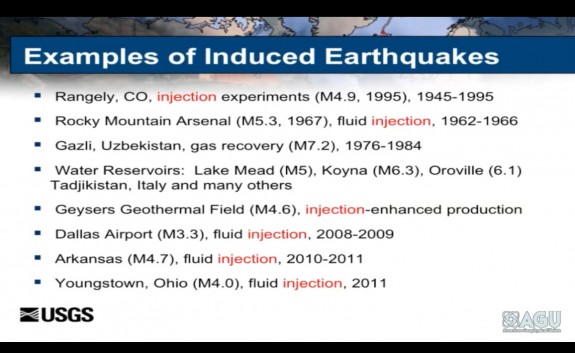Oklahoma’s Biggest-Ever Earthquake Was Likely Man-Made
By injecting fluid deep underground, people may have caused Oklahoma’s big 2011 earthquake

A map of the shaking caused by the November 2011 Oklahoma earthquake. Photo: USGS
In 2011, a magnitude 5.6 earthquake hit Oklahoma, injuring two people and damaging fourteen homes and a highway. It was the strongest earthquake ever recorded in the modern era in Oklahoma, says Columbia University, and in a new study researchers suggest that this quake was caused by human activity—specifically, the injection of fluid into the ground as part of a gas extraction project.
If the researchers’ findings stand up, this will the largest earthquake known to be caused by fluid injection. Columbia:
The recent boom in U.S. energy production has produced massive amounts of wastewater. The water is used both in hydrofracking, which cracks open rocks to release natural gas, and in coaxing petroleum out of conventional oil wells. In both cases, the brine and chemical-laced water has to be disposed of, often by injecting it back underground elsewhere, where it has the potential to trigger earthquakes. The water linked to the Prague quakes was a byproduct of oil extraction at one set of oil wells, and was pumped into another set of depleted oil wells targeted for waste storage.
The big quake comes amidst a recent increase in earthquake activity in the region, says the USGS.
From 1972-2008 about 2-6 earthquakes a year were recorded by the USGS… In 2008 the rate of earthquakes began to rise, with over a dozen earthquakes occurring in the region east- northeast of Oklahoma City and southwest of Tulsa, Oklahoma. In 2009 the rate of seismicity continued to climb, with nearly 50 earthquakes recorded–many big enough to be felt. In 2010 this activity continued.

By increasing the stress underground from the weight of water in a reservoir or from pumping fluid deep underground, humans are able to trigger earthquakes in a variety of ways. Most induced earthquakes, however, are usually really small. Photo: AGU / USGS
Previously, says the Associated Press, researchers thought that the 2011 Oklahoma earthquake was “too powerful to be man-made.” Whether wastewater injection can cause earthquakes is not even a debate anymore. The question was whether such a big tremblor could be triggered in such a way. In the new study, says the AP’s Seth Borenstein, the scientists suggest that a long history of pumping wastewater underground eventually caused the fault to slip.
This area of Oklahoma had been the site of oil drilling going back to the 1950s, and wastewater has been pumped into disposal wells there since 1993, the study authors said. Water and other fluids used for drilling are often pumped more than a mile below ground.
The report said there was a noticeable jump in the well pressure in 2006. USGS geophysicist Elizabeth Cochrane described the pressure increase from injections as similar to blowing more air in a balloon, weakening the skin of the balloon.
… The evidence isn’t as complete as other smaller earthquakes that have been linked conclusively to injections of waste, such as those in Arkansas, Colorado and Nevada, said co-author Heather Savage of Columbia.
But with the quake at the “right place” at the well, the increased pressure and the other smaller quakes across the region triggered by injections, “it becomes compelling,” she said.
Meanwhile, the Oklahoma Geological Survey maintains that the large, magnitude 5.6 earthquake was the result of natural processes, says the AP. In a 2012 press conference Austin Holland with the Oklahoma Geological Survey also denounced the claim that wastewater injection is driving the recent surge in Oklahoma’s earthquakes: “No changes in oil and gas activities are immediately apparent that could explain the dramatic rise in earthquake rates.”
If the new claim stands up, and the large earthquake is actually due to wastewater injection, then it could mean that fault lines are even more susceptible to being tripped by human activity than we thought.
More from Smithsonian.com:
Researchers Find Fracking Might Cause Earthquakes After All
How Humans Cause Earthquakes
/https://tf-cmsv2-smithsonianmag-media.s3.amazonaws.com/accounts/headshot/smartnews-colin-schultz-240.jpg)
/https://tf-cmsv2-smithsonianmag-media.s3.amazonaws.com/accounts/headshot/smartnews-colin-schultz-240.jpg)